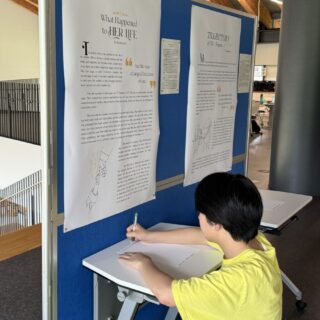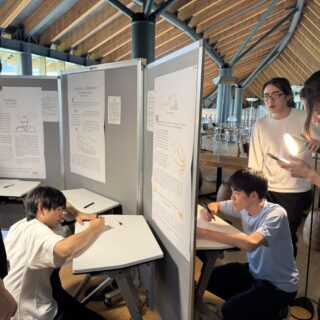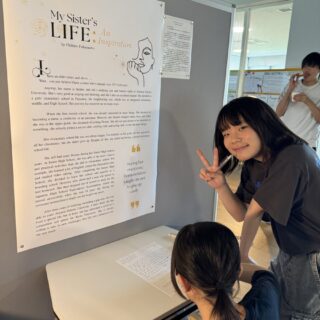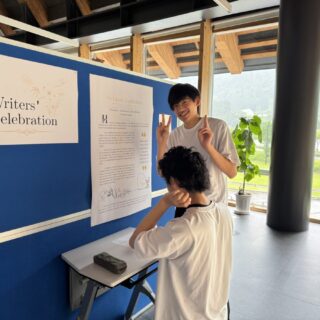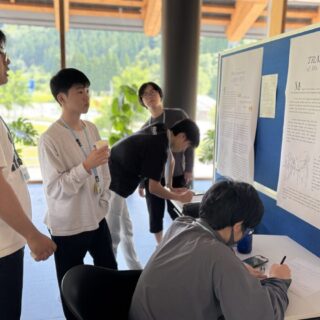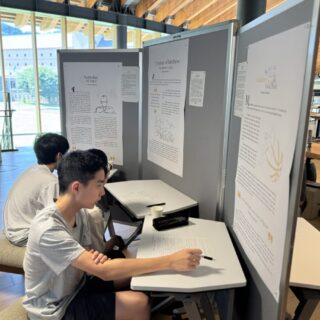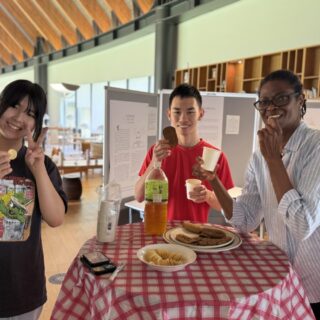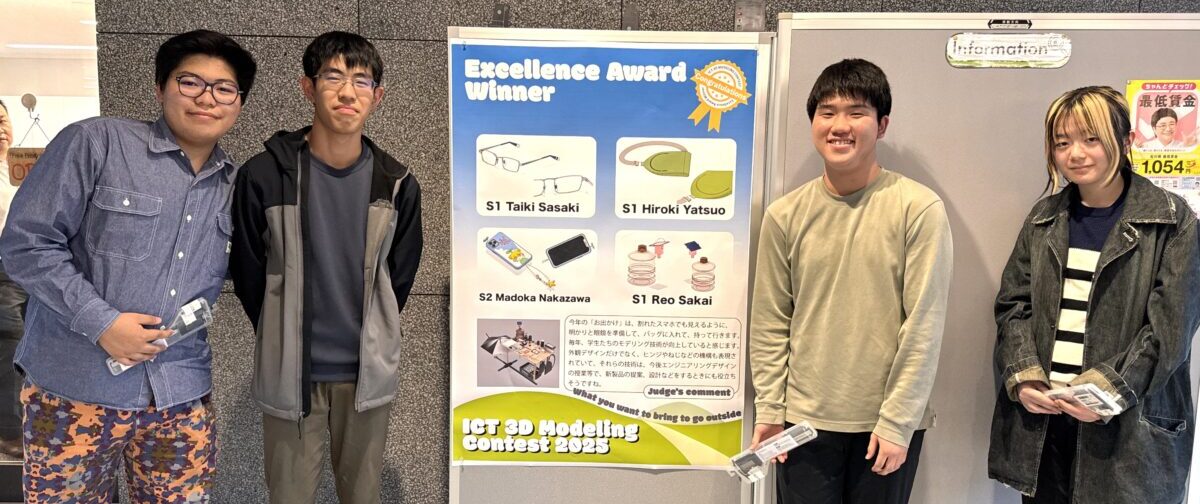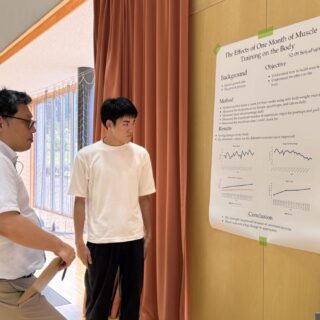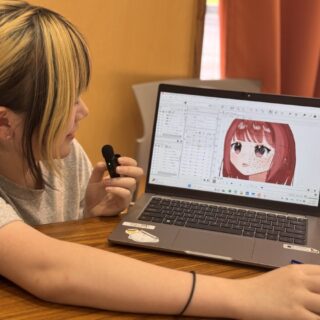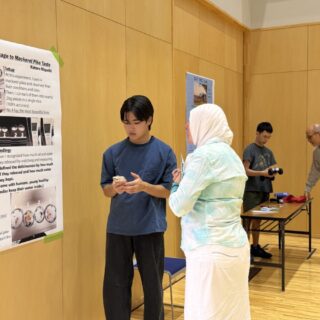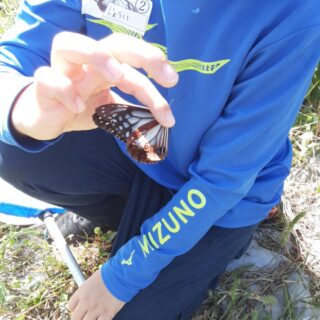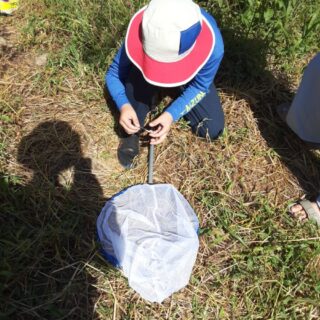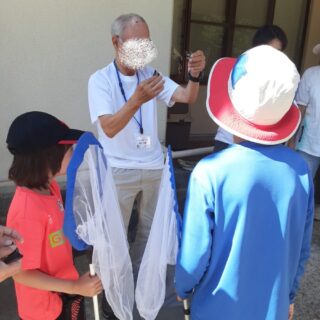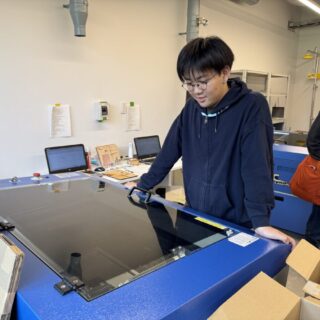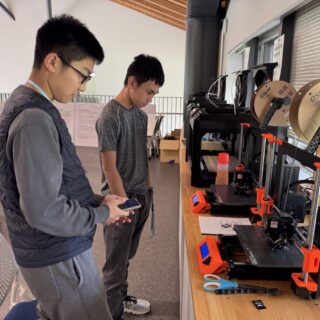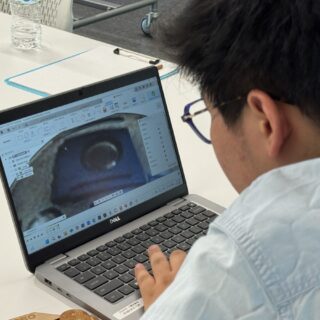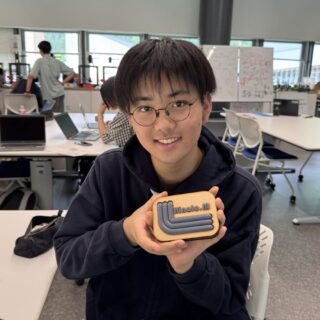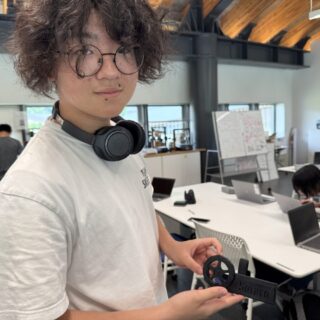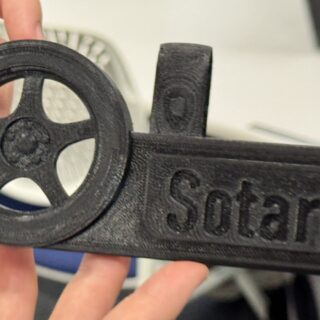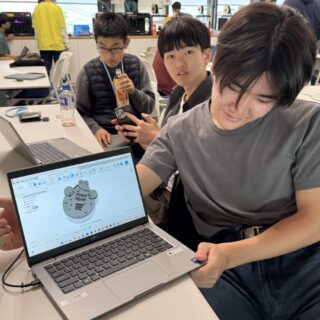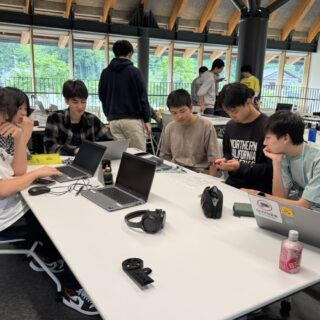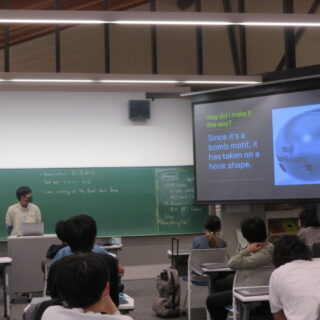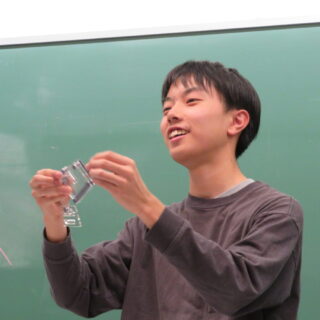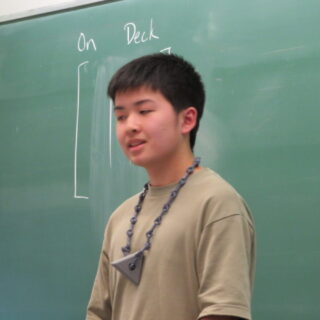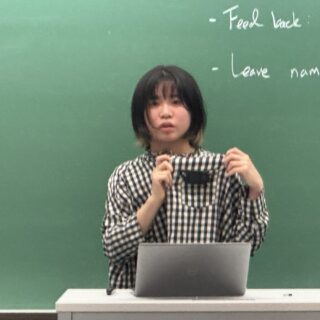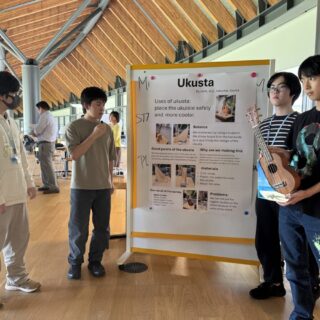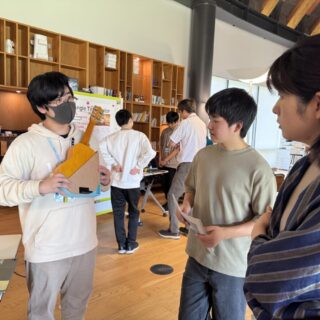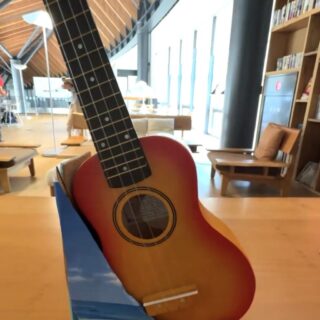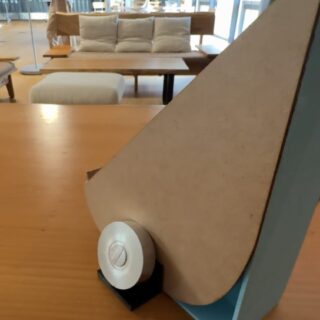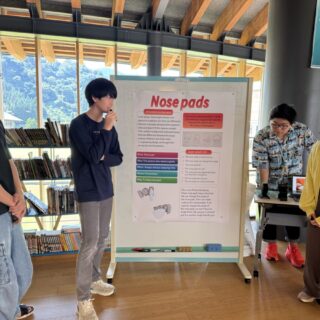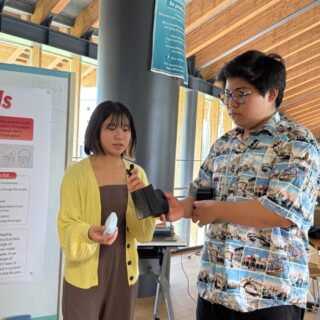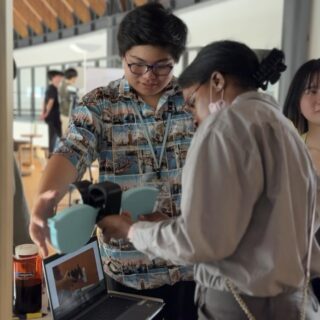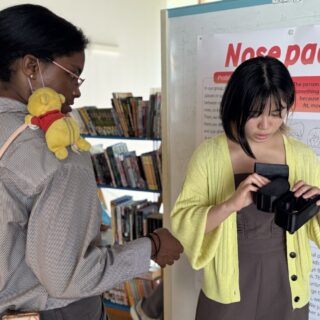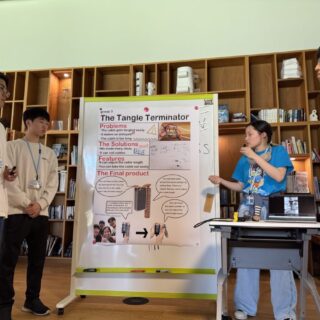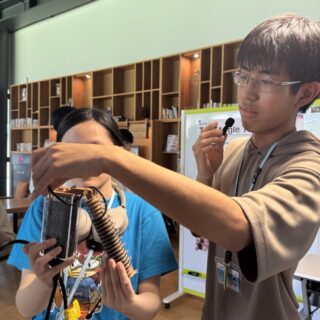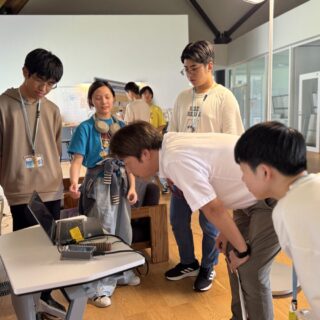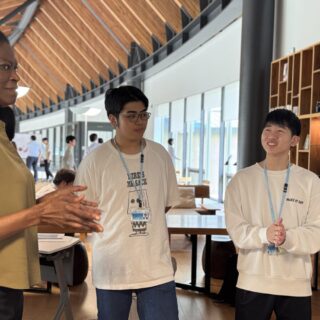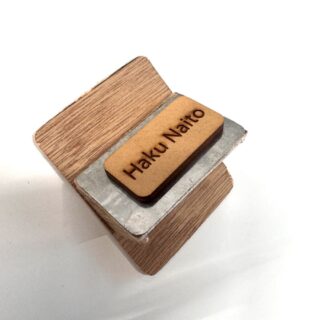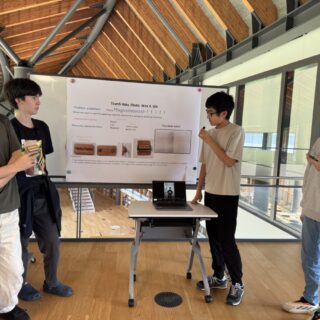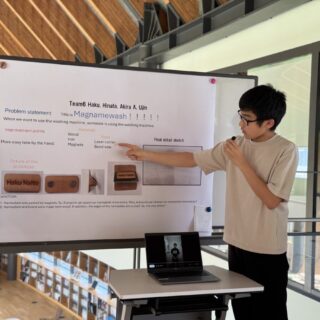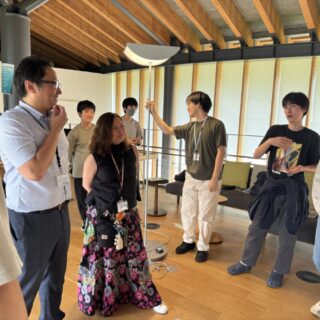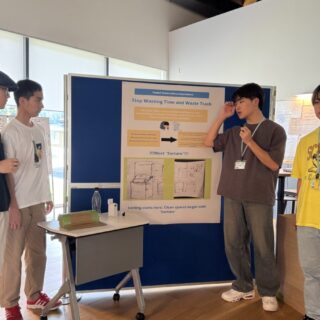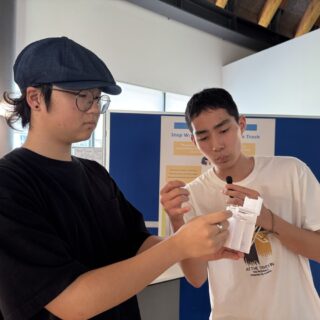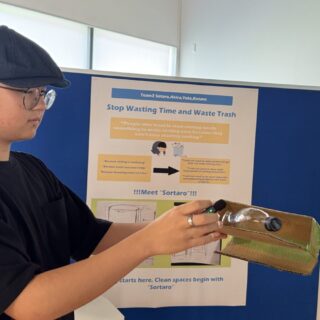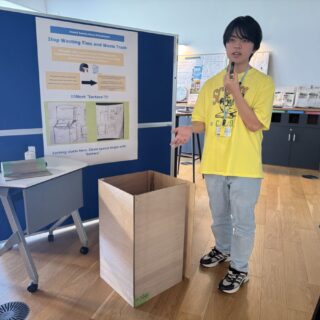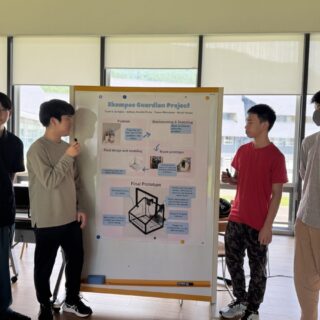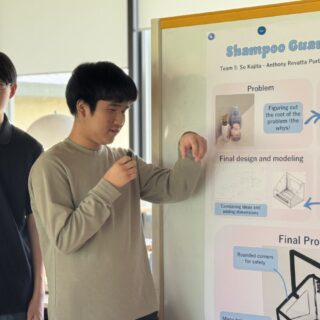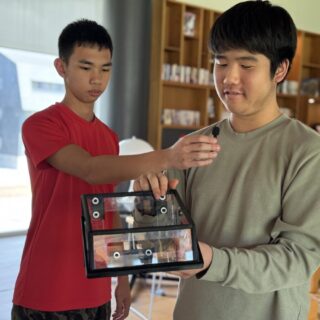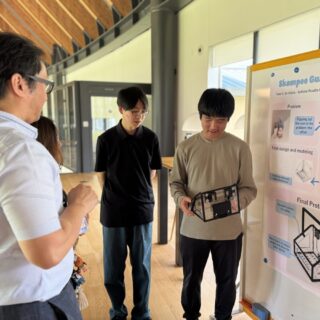Faculty
学科
こんにちは、英語科目担当のポーリン・ベアードです。
今学期、2年生のリーディング・ライティングの授業では、学生たちが「Profile Essay」を書くために、自分にとってインスピレーションを与えてくれる人物にインタビューを行いました。家族について書いた学生も多く、メモを取りながら文章を仕上げていきました。書く過程そのものも価値あるものでしたが、最後に行われた「Writer’s Celebration」で最も重要な気づきがありました。
学生たちは、自分の作品を英語と日本語で掲示板に貼り、他の学生や教職員に披露しました。その様子を見て、私は「家族の物語を書くこと」が、学生たちが作家として、また思考する人としてのアイデンティティを育むための特別な窓(きっかけ)となることに気づきました。
また、Writer’s Celebrationを実施したことで、学生たちが英語で自然に物語を用いながら、自分の価値観を探求できることがわかりました。祖父母や両親について語る中で、共通するテーマ―「優しさ」「強靭さ」「リーダーシップ」「創造性」「感情的な強さ」―が見えてきました。ある学生は、祖父が雨の日に傘を差し出してくれたという小さな行為が、どれほど心に響いたかを語りました。これらの物語は単なる子どもの頃の思い出ではなく、世代を超えて受け継がれる教訓であり、学生自身の声で語られたものです。これを読むと、ライティングは文法や構造だけではなく、「何が大切で、なぜそれが大切なのか」を理解することでもあると改めて感じます。
発表中、学生たちは教員や他の学生たちからのコメントを誇らしげに読みました。自分の人生から生まれた文章だからこそ、彼らはその作品に強い愛着を持っていました。多くの学生が「自分は意味(価値)のある物語を語れる」という発見をし、他の学生たちも「私たちはこんなにも共通点を持っている」ということに気づきました。例えば、ある学生が母親の前向きな姿勢について書いた文章は、別の学生が父親の思いやりについて語った文章と響き合います。学生全員が互いの文章を目にする機会はそう多くありません。だからこそ、こうした共有の時間は、ライティングを皆で分かち合えるものにし、ワークシートのような問題解決学習では決して生まれない一体感を育てます。
教員にとっても、学生がどのように考え、感じ、意思決定をしているかを垣間見る貴重な機会となりました。学生が何を大切にしているのか―友情、努力、優しさ、家族―を知ることで、今後の授業づくりにも役立ちます。
Writer’s Celebrationは、単なる課題を「仲間と価値観を共有できる体験」に変えました。そのことは、学生が自分の物語を語る時、彼らは「自分は書き手である」と認識し、私たち教員も学生をより深く理解できるのです。
【Writer’s Celebration】
一般的に、執筆における成果と努力を称え、作家同士が互いに励まし合うイベントです。学生の文章を発表することで、モチベーションの維持、学びの定着、文章力向上や、仲間や学校コミュニティと喜びを共有することで達成感を高めることを目的として実施されます。
ポーリン・ベアード
Celebrating the Hearts Behind the Writing and the Community that Grows From It
Pauline Baird an English teacher at ICT.
This semester, students in the 2nd Year reading and writing class interviewed people who inspired them to write a Profile Essay. Several students wrote about family members, took field notes, and drafted profile essays. The writing process itself was valuable; however, the most meaningful insights emerged during the “Writer’s Celebration” at the end. As students shared their work on bulletin boards for the entire school to read (in English and in Japanese), I began to see how family-story writing opens a unique window into students’ developing identities as writers and thinkers.
The celebration showed that students can naturally use narrative, in English, to explore personal values. As the students shared stories about grandfathers, mothers, and fathers, common themes appeared—kindness, resilience, leadership, creativity, and emotional strength. One student described how a grandfather’s small act—an umbrella given on a rainy day—touched him deeply. These stories were more than childhood memories. They were lessons passed across generations, told in the students’ own voices. Reading them reminds us that writing is not only about grammar or structure. It is also about understanding what matters and why.
During the celebration, students read comments by teachers and others with pride. They had ownership of their writing because it came from their lives. Many discovered that they could tell a meaningful story, and their classmates discovered how much we all have in common. For example, a student’s reflection on her mother’s positive mindset might echo another student’s story about his father’s compassion. It is not often that all students get to see other students’ writing. Thus, these shared moments make writing public and build a sense of community in a school that no worksheet can create.
For teachers, the celebration offered a rare window into how students think, feel, and make decisions. We learn what our students value—friendship, hard work, kindness, and family—and this helps us shape future lessons. A writer’s celebration turned a simple assignment into a shared human experience. It reminds us that when students tell their stories, they learn to see themselves as writers, and we learn to see students a little more clearly, too.
[Writer’s Celebration]
Generally, it is an event that celebrates achievements and efforts in writing, where writers encourage one another. The purpose is to publish student-writing to maintain motivation, reinforce learning, improve writing skills, and enhance the sense of accomplishment by sharing joy with peers and the school community.
Pauline Baird
 デザイン&ファブリケーション部顧問の林 道大です。本年度も夏季休暇中の課題として、3DCADモデリングに学生たちが取り組みました。今年のテーマは「お出かけに持って行くもの」で、1・2年生の学生たちから30点以上の作品が提出されました。提出された作品はさまざまなジャンルのものが網羅されており、全部を持ってお出かけすれば、楽しく、便利な遠足となりそうです。提出された全てを審査員たちで審査を行い、優秀賞4作品を選出しました。
デザイン&ファブリケーション部顧問の林 道大です。本年度も夏季休暇中の課題として、3DCADモデリングに学生たちが取り組みました。今年のテーマは「お出かけに持って行くもの」で、1・2年生の学生たちから30点以上の作品が提出されました。提出された作品はさまざまなジャンルのものが網羅されており、全部を持ってお出かけすれば、楽しく、便利な遠足となりそうです。提出された全てを審査員たちで審査を行い、優秀賞4作品を選出しました。
優秀賞となった作品について、それぞれ解説していきます。
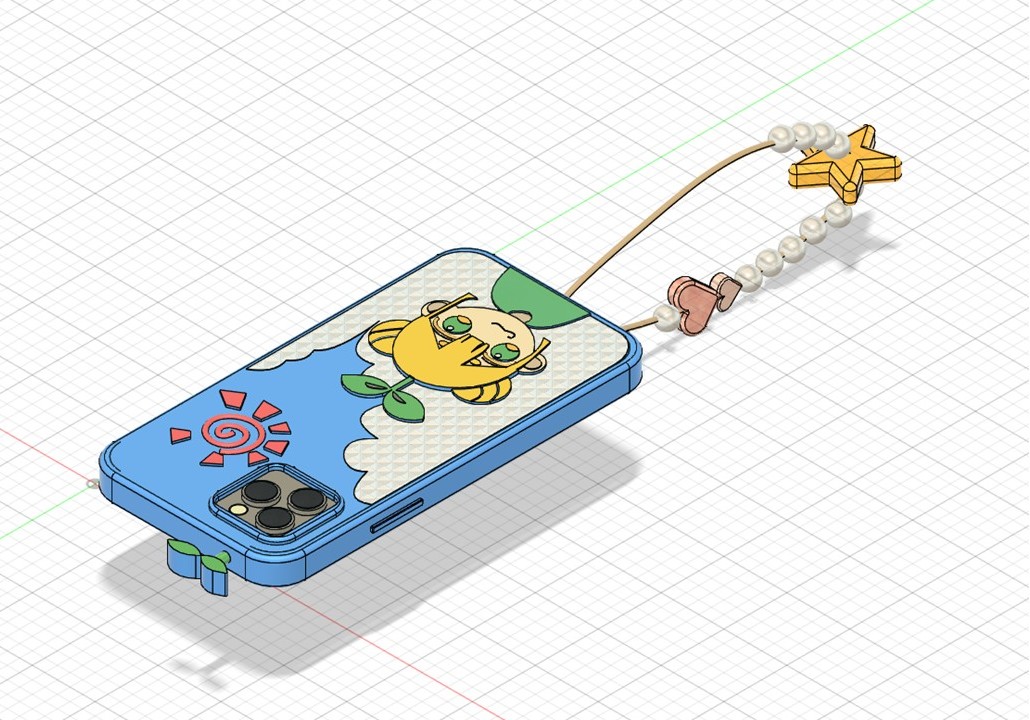 まず、2年生中澤 円香さんの作品「わたしのスマホ」です。幾何学的な形状としてはシンプルなスマホをモデリングしていますが、かなりデコっています。円弧や直線の組み合わせで、かわいらしいキャラクターをうまく再現しています。ストラップのビーズの表現も上手です。輝く太陽もCADでは難しいと思われる手書き風にモデリングされています。画面が割れているところまで表現しているのも、手が込んでいました。
まず、2年生中澤 円香さんの作品「わたしのスマホ」です。幾何学的な形状としてはシンプルなスマホをモデリングしていますが、かなりデコっています。円弧や直線の組み合わせで、かわいらしいキャラクターをうまく再現しています。ストラップのビーズの表現も上手です。輝く太陽もCADでは難しいと思われる手書き風にモデリングされています。画面が割れているところまで表現しているのも、手が込んでいました。
2年生中澤さんコメント
制作時間:1日少しずつ作業して、1週間くらいかかりました。
こだわり:カメラレンズの周辺やキャラクターの表情など細かいところまでモデリングしました。やっぱり、割れたスクリーンが一番のポイントです。
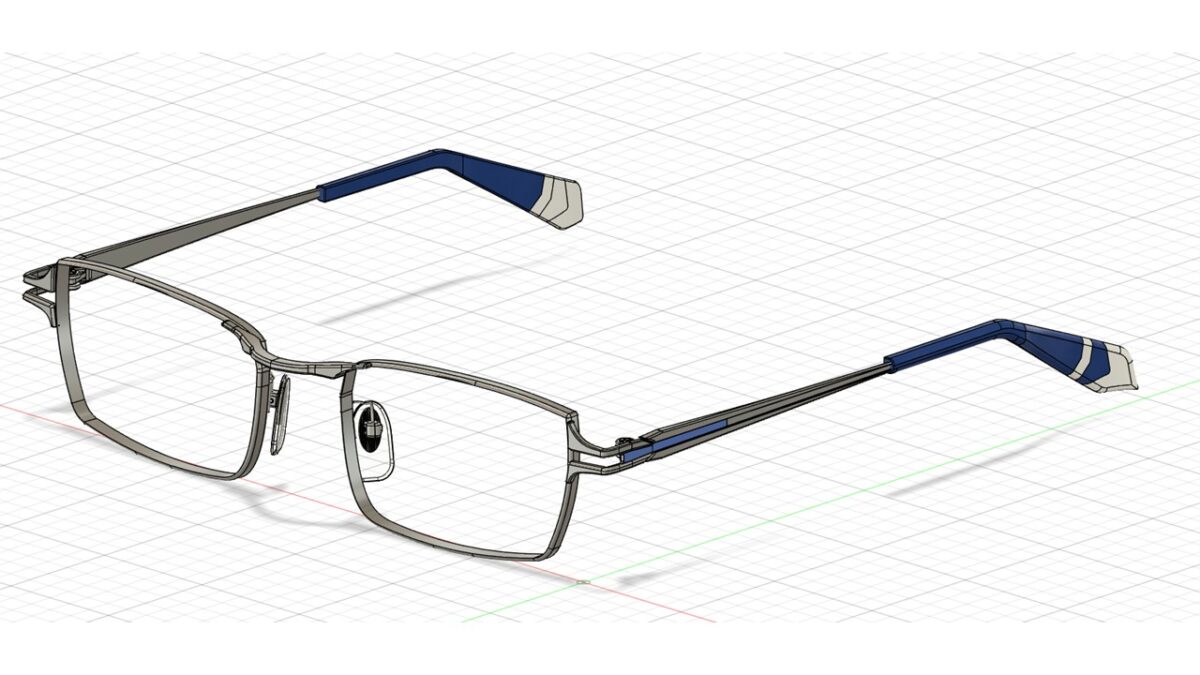
次は、1年生笹木 大暉さんの作品「わたしの眼鏡」です。とてもリアルにモデリングされた眼鏡です。眼鏡屋さんのカタログに載っていそうです。全体の形状だけでなく、リム、ブリッジ、智、鼻パッド、丁番、テンプルまでしっかりと再現されています。複雑な曲面で構成されているパーツも、とても丁寧に形状が再現されています。この眼鏡をかけたら、少し賢くなるような気がするのは、制作者の思いが作品に反映されているのでしょうか。
1年生 笹木さんコメント
制作時間:6時間くらいだと思います。
こだわり:自分が使っている眼鏡を良く観察しました。特にレンズをはめるリムの立体感に注意してモデリングしました。
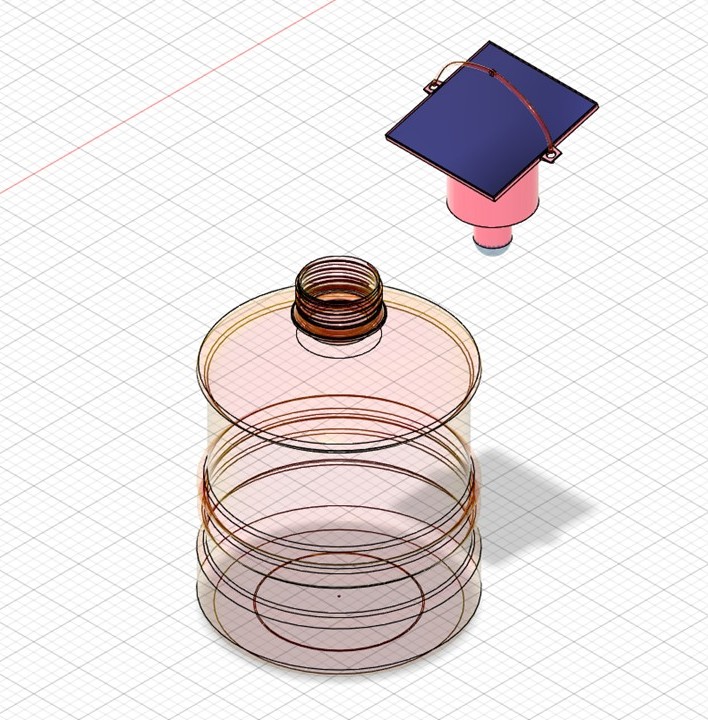
次は、1年生 坂井 麗央さんの作品「わたしのランタン」です。全体の形状をバランス良くモデリングしています。灯したり、消したりする機構や、燃料を入れる部分、ネジ締めする蓋の部分も、その機能が説明できるように丁寧に作成しています。薄暗いテントの中で炎がゆらゆらと揺らめく様子をCGで再現したら、とても美しい動画となるのではないでしょうか。CG(コンピュータグラフィックス)コンテストでも上位入賞できると思います。
1年生 坂井さんコメント
制作時間:3時間くらいの作業を2、3日続けました。
こだわり:テクスチャの設定や蓋部分のねじ形状にこだわりました。蓋部分は3Dプリントしたら実際の蓋として使えるはずです。
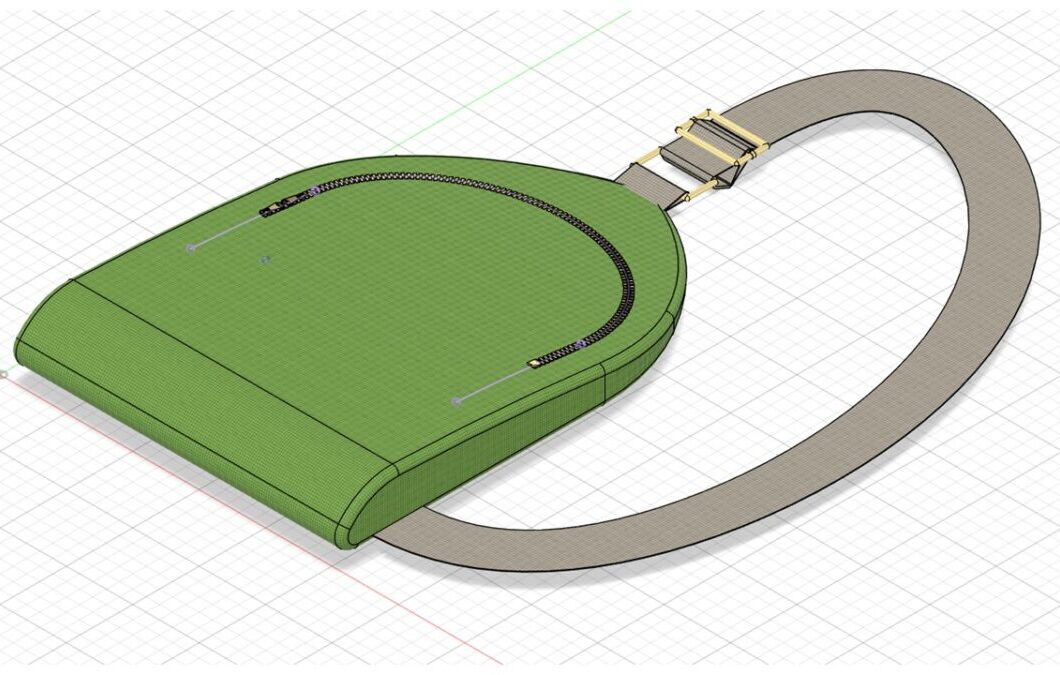 最後は、1年生 八尾 拓樹さんの「わたしのバッグ」です。こちらも曲面が多い難しい形状をバランス良くモデリングしてあります。ファスナーやベルト金具などの細かい部分まで、しっかりと作成してあります。ベルトを金具に通したり、バッグに固定したりする箇所のモデリングも複雑な操作が必要だったと思います。授業内で教えてもらっていない、機能や操作が必要な場面も多くあったでしょう。それらを自分で調べて、学び、成果が出た経験は、今後の他の課題でも役に立つことと思います。ベルトの曲げ方を3次元的に(奥行き方向に曲げる)すれば、もっとリアルに見えますので、ぜひ挑戦してみて欲しいと思います。
最後は、1年生 八尾 拓樹さんの「わたしのバッグ」です。こちらも曲面が多い難しい形状をバランス良くモデリングしてあります。ファスナーやベルト金具などの細かい部分まで、しっかりと作成してあります。ベルトを金具に通したり、バッグに固定したりする箇所のモデリングも複雑な操作が必要だったと思います。授業内で教えてもらっていない、機能や操作が必要な場面も多くあったでしょう。それらを自分で調べて、学び、成果が出た経験は、今後の他の課題でも役に立つことと思います。ベルトの曲げ方を3次元的に(奥行き方向に曲げる)すれば、もっとリアルに見えますので、ぜひ挑戦してみて欲しいと思います。
1年生 八尾さんコメント
制作時間:1日少しずつ作業して、3日か4日くらいかかりました。
コメント:カーブしたファスナーと、ベルト金具部分の形状にこだわりました。
受賞作のみ、解説をしましたが、受賞とはならなかった他の作品もとても素晴らしかったです。「お出かけに持って行くもの」がテーマということで、バッグや眼鏡、スマホ、ポータブルバッテリーなどが多かったのですが、留学生は2名とも「ナイフ」をモデリングしていました。人間本来のお出かけして生きていく力を感じましたし、大自然の中で役に立ちそうな良い形状でした。来年も継続してコンテストを開催していきますので、学生たちの3DCADスキルのさらなる向上に期待しています。
林 道大

I am Michihiro Hayashi, advisor for the Design & Fabrication Club. This year, as part of the summer vacation assignment, students worked on 3D CAD modeling. The theme was “Things to Take on an Outing”. There were more than 30 submissions from 1st and 2nd year students. The submissions covered a wide range of genres—if you took all of them on a trip, it would surely be a fun and convenient excursion! After careful evaluation by the judges, four outstanding entries were selected for awards.
Let’s take a closer look at the award-winning pieces.
 2nd year student Madoka Nakazawa: My Smartphone
2nd year student Madoka Nakazawa: My Smartphone
Although the geometric shape of a smartphone is simple, this model is highly decorated. Using a combination of arcs and straight lines, the student skillfully recreated a cute character. The bead strap is well represented, and even the shining sun—usually difficult to model in CAD—was given a hand-drawn look. The cracked screen detail was an impressive touch.
Comment from Madoka
Production time: Worked a little each day, about a week in total.
Focus points: Paid attention to details like the camera lens area and the character’s facial expression. The cracked screen is definitely the highlight.
 1st year student Taiki Sasaki: My Glasses
1st year student Taiki Sasaki: My Glasses
This model of eyeglasses is extremely realistic—almost like something from an optical shop catalog. Not only the overall shape, but also the rims, bridge, end pieces, nose pads, hinges, and temples were faithfully reproduced. Even the complex curved surfaces were carefully modeled. Wearing these glasses might make you feel smarter—perhaps reflecting the creator’s intention.
Comment from Taiki
Production time: About 6 hours.
Focus points: Closely observed my own glasses, especially the three-dimensional feel of the rims that hold the lenses.

1st year student Reo Sakai: My Lantern
The overall shape is well balanced, and the model includes functional details such as the mechanism for lighting and extinguishing the lantern, the fuel compartment, and the screw-on lid. These were created so their functions could be explained clearly. If the flickering flame inside a dim tent were rendered in CG, it would make a stunning video—possibly even a top entry in a CG contest.
Comment from Reo
Production time: Worked 2–3 hours a day for 2–3 days.
Focus points: Paid attention to texture settings and the screw shape of the lid. The lid could probably be 3D printed and used in real life.
 1st year student Hiroki Yatsuo: My Bag
1st year student Hiroki Yatsuo: My Bag
This piece features many curved surfaces, which are difficult to model, yet they are well balanced. Details such as zippers and metal buckles were carefully crafted. Modeling the parts where the belt passes through the buckle and attaches to the bag required complex operations. There were likely many functions and techniques not taught in class, so the student must have researched and learned independently—a valuable experience for future projects. If the belt were bent three-dimensionally (with depth), the model would look even more realistic, so I encourage trying that next time.
Comment from Hiroki
Production time: Worked a little each day, about 3–4 days in total.
Focus points: Focused on the curved zipper and the shape of the belt buckle.
Although I only introduced the award-winning works, the other submissions were also excellent. Since the theme was “Things to Take on an Outing,” many students modeled bags, glasses, smartphones, and portable batteries. Interestingly, international students chose to model knives, perhaps reflecting humanity’s innate survival instincts and the usefulness of such tools in nature.
I plan to continue this contest next year and look forward to seeing even greater improvements in students’ 3D CAD skills.
Michihiro Hayashi
 みなさん、こんにちは。物理科目を担当している伊藤 周です。今回は、毎年恒例の「STEMフェア2025」についてお話しします。
みなさん、こんにちは。物理科目を担当している伊藤 周です。今回は、毎年恒例の「STEMフェア2025」についてお話しします。
STEMフェアは、国際高専の夏休み課題「Summer STEM Project」の成果を発表する場で、毎年9月下旬に開催されています。簡単に言えば、夏の自由研究の発表会です。テーマは学生が自由に決めますが、今年は特に1年生のアイデアがとてもユニークで、これまでにないテーマがたくさんありました。国際高専が始まって8年、STEMフェアも今回で8回目(2年生の分も合わせると15回目)になりますが、毎年新しい発想に出会えるのは本当に面白いですね。
さらに、今年は実験や製作にすごく時間と労力をかけている学生が多かったのも印象的でした。たとえば、魚のプラスチック汚染を調べるために何十匹も釣って内臓を確認したり、身長への影響を調べるために約3,000回ジャンプしたり、アニメーションを作るために何十枚ものカットを描いたり、海洋ゴミを調べるために地元の半島を一周したり、炎天下を7km歩いたり…。
発表自体はポスター1枚と10分ほどの説明だけですが、その裏にある努力や時間を想像すると、本当に感動します。
個人的には、こういう「とにかくやってみた!」というプロジェクトが大好きです。たとえ科学的に完璧じゃなくても、その熱意を評価したくなります。ただ、発表としてはやっぱり図や表を使って、そこから考察をまとめることも大切なので、その点は学生たちに伝えました。
STEMフェアは、学生の頑張りと先生方の協力で、今や白山麓キャンパスの名物イベントになりました。まだ1・2年生なので高度な研究とは言えませんが、学生たちの自由な発想や興味を形にしたプロジェクトを見るのは本当に楽しいです。これからも、このイベントを続けていきたいです。
伊藤 周
 Hello everyone, I’m Meguru Ito, a physics teacher. Today, I’d like to talk about our annual STEM Fair, in this case STEM Fair 2025.
Hello everyone, I’m Meguru Ito, a physics teacher. Today, I’d like to talk about our annual STEM Fair, in this case STEM Fair 2025.
The STEM Fair is a venue for presenting the outcomes of the ICT’s summer assignment, the Summer STEM Project, and it is held every year in late September. Simply put, it’s a showcase for summer independent research. Students choose their own themes, but this year, the ideas from 1st year students were especially unique, with many topics we’ve never seen before. Since ICT was founded eight years ago, this is the eighth STEM Fair (or the fifteenth if we include the 2nd year presentations), and it’s always exciting to encounter fresh ideas every year.
What stood out this time was how much time and effort many students invested in ttheir experiments and production. For example, some caught dozens of fish to examine their organs for plastic contamination, others jumped about 3,000 times to study the effect on height, created animations by drawing dozens of frames, circled a local peninsula to investigate marine debris, or walked 7 km under the blazing sun.
Although each presentation consists of just one poster and about ten minutes of explanation, imagining the effort and time behind them is truly moving.
Personally, I love these “just give it a try!” projects. Even if they’re not scientifically perfect, I want to recognize that enthusiasm. Of course, for a proper presentation, using charts and tables and drawing conclusions from them is also important, so I made sure to convey that to the students.
Thanks to the students’ hard work and the teachers’ support, the STEM Fair has become a signature event at the Hakusanroku Campus. While 1st and 2nd year students’ projects aren’t advanced research yet, seeing their ideas and interests take shape is incredibly enjoyable. I hope we can keep this event going for years to come.
Meguru Ito
 こんにちは。白山麓キャンパスで英語を教えているジェームス・テイラーです。
こんにちは。白山麓キャンパスで英語を教えているジェームス・テイラーです。
白山麓キャンパスで暮らし、働くことの素晴らしい点の一つは、周囲に豊な自然があることです。毎日色んな面白い生き物を間近で見られます。例えば、毎年9月下旬に瀬戸地域に現れる蝶のアサギマダラです。
アサギマダラ(英語名:Chestnut tiger butterfly)は面白い蝶です。なぜかというと、毎年とても長い旅をするからです。長い旅の途中で立ち寄る場所の一つが瀬戸で、白山麓キャンパスからほんの数十メートルの場所にやって来ます。
地元の方々は、蝶を呼び寄せるために、使われていない畑にフジバカマを植えています(白山麓キャンパス向かいの「道の駅 瀬女」付近)。この場所は「アサギマダラ空の駅・白山」と呼ばれていて、アサギマダラファンクラブ白山は、毎年ここでマーキング調査をしています。2025年9月27日(土)、私は息子と一緒に蝶のマーキング調査体験会に参加しました(主催:アサギマダラファンクラブ白山、尾口コミュニティセンター、白山麓里山活性化協議会)。
まず、アサギマダラファンクラブ白山の中村 明男さんのお話しを聞きました。中村さんは、蝶のライフサイクルや移動の習性について説明してくれました。また、例として自分で捕まえてマーキングしたアサギマダラを見せてくれた後、マーキングの仕方を説明・実演してくれました。
蝶は捕まえられると、死んだふりをするので、羽に文字が書きやすくなります。フェルトペンを使って、捕まえた場所(私たちの場合は「白山」)、日付(9/27)、自分の名前又はイニシャル、そして捕まえた順番を示す番号を羽の白いところに丁寧に書きます。
また、この情報を紙にも記録し、中村さんが他の地域にあるアサギマダラファンクラブとオンラインで共有できるようにします。さらに、私たちがマーキングした蝶を誰かが捕まえた場合に、連絡をもらえるように連絡先も記入します。
過去には、瀬戸でマーキングされたアサギマダラが、四国、九州、沖縄、さらには台湾でも見つけられたことがあります(瀬戸から台湾までは、2,000キロ以上も離れています!)。天候の変化により、近年は蝶の数が少なかったのですが、息子は3匹捕まえてマーキングすることができました。
その3匹の蝶たちはどこまで飛んでいくのかな。
ジェームス・テイラー
 Hello everyone. I’m James Taylor, one of the English teachers at ICT’s Hakusanroku Campus.
Hello everyone. I’m James Taylor, one of the English teachers at ICT’s Hakusanroku Campus.
One of the best things about living and working at Hakusanroku Campus is the abundance of nature that surrounds us. We get to see a wide variety of interesting creatures up close. An example of this is the Chestnut tiger butterflies that appear in the Seto area at the end of every September.
Chestnut tiger butterflies are known in Japanese as “Asagimadara”. They are an interesting type of butterfly because they migrate very long distances, and one of the places they stop en route is just a few dozen metres down the road from our school. To encourage the butterflies, local residents and community groups plant Boneset (“Fujibakama” in Japanese) in disused allotments – like those near the Roadside Station Sena opposite ICT -- and call it the “ASAGIMADARA SORANOEKI (Sky Station)・HAKUSAN”. The Asagimadara Fan Club Hakusan conducts a marking survey here every year. On Saturday, September 27th, 2025, my son and I participated in a butterfly marking event organised by the Asagimadara Fan Club, Oguchi Community Centre, and the Hakusanroku Satoyama Revitalisation Council.
First, we listened to a lecture by Mr. Nakamura of the Asagimadara Fan Club Hakusan, who told us about the butterflies’ life cycle and migratory behaviour. Mr. Nakamura showed us examples of Chestnut tiger butterflies that he’d caught and marked, then gave an explanation and demonstration of how to mark them. Once they’ve been caught, the butterflies play dead, so it’s easy to write on the white part of their wings. Using a felt tip pen, you have to carefully write the location (Hakusan or 白山 for us), the date (9/27), then our name or initials and a number to denote the order in which we caught and marked the butterfly. We also had to write all this information on a paper so that Mr. Nakamura could enter it online and share it with other Asagimadara Fan Clubs in other regions of Japan. We also had to write our contact details, so that if someone catches a butterfly we’ve marked, we can be contacted and told where it got to.
In previous years, Chestnut tiger butterflies that have been marked in Seto have later been found in places like Shikoku, Kyushu, Okinawa, and even Taiwan – that’s over 2,000 kilometres from Seto. The changes in the weather have meant that last year and this year there weren’t so many butterflies, but my son managed to catch and mark three.
I wonder how far they’ll travel.
James Taylor
Related Articles on Last Year’s ICT Chestnut Tiger Butterfly Marking Event
プロジェクト1:ネームタグ制作
こんにちは。白山麓キャンパスで1年生のエンジニアリングデザインを担当しているブランドン・ウォルファースです。国際高専のエンジニアリングデザインの授業では、学生たちが多様なプロジェクトに取り組みますが、デザインプロセスへの「導入」として、最初のプロジェクト「個性を表現するネームタグの制作」に挑戦しました。
このプロジェクトにはいくつかの条件がありました。ネームタグは着用可能であること、指定されたサイズ内に収まること、白山麓キャンパスにある3Dプリンターやレーザーカッターを使用して制作すること、そして制作者本人の特徴を視覚的に表現することが求められました。
学生たちはアイデアの発想から始まり、プロトタイピング(試作品作り)を通じて、特徴と機能の関係性について学びました。プロジェクトの締めくくりには、英語でのプレゼンテーションを行い、クラスメートに自作のネームタグを紹介しました。
エンジニアリングデザインの魅力は、テストやクイズとは異なり、問題解決に「唯一の正解」が存在しない点です。学生たちがそれぞれの方法で課題に取り組む様子は非常に興味深く、多くの学生が自身の趣味や好きなメディアをテーマにすることで、作品に個性を反映させていました。これは学生たちにとって初めてのデザイン体験であり、今後の成長が非常に楽しみです。
プロジェクト2:チームによる課題解決
前学期の後半には、1年生はチームプロジェクトにも取り組みました。このプロジェクトの目的は、学生が日常生活を観察し、「毎日使っている中で最も不便なもの」を特定し、それに対する個人的な課題を解決する方法を考案することです。
この活動で特に興味深いのは、学生たちが日常の中でどのような不便さを認識し、それにどう向き合うかという点です。各グループが取り組んだ課題は多様でしたが、共通して求められたのは、「対象物の使用方法の理解」「目的の機能を果たすために必要な特徴の把握」、そして「人間中心の設計の重要性」でした。
以下に、各グループの取り組みをご紹介します。
1. Ukusta(ウクスタ)
このグループは、白山麓キャンパスのリビングコモンズにあるウクレレのための新しいスタンドの設計に挑戦しました。楽器の安定性を高めるとともに、空間の美観を向上させることを目指しました。
2. Nosepads(ノーズパッド)
このグループは、さまざまな眼鏡やサングラスに対応できる調整可能なノーズパッドの開発に取り組みました。鼻の形状に合わせてフィットするよう設計されており、試作品はサイズの関係上、拡大モデルでの提示となりました。
3. The Tangle Terminator(タングル・ターミネーター)
このグループは、ノートパソコンの充電ケーブルがバックパック内で絡まりやすいという問題に着目し、収納性を向上させるための整理ツールを考案しました。持ち運びの利便性を重視した設計です。
4. Magnamewash(マグネームウォッシュ)
このグループは、白山麓キャンパスの寮にあるランドリー設備の利用状況を整理する方法を模索しました。誰がどの機械を使用しているかを簡単に把握できる、設置・使用が容易で情報伝達が明確な仕組みを目指しました。
5. Sortaro(ソルタロウ)
このグループは、ごみの分別が複雑で時間がかかるという問題に取り組みました。日本の分別システムに慣れていない人でも使いやすく、適切に分別できる一体型のごみ箱の設計を目指しました。
6. Shampoo Guardian Project(シャンプー・ガーディアン・プロジェクト)
このグループは、寮のシャワー室における収納スペースの不足に着目しました。シャワー中に使用するボトル類を簡単に持ち運び、アクセスできる収納ツールの開発に取り組みました。
後学期に学生たちがどのようなプロジェクトに挑戦するのか、今から非常に楽しみにしています。
ブランドン・ウォルファース

Project 1:Creating Name Tags
Hello everyone, this is Brandon Wohlfarth, one of the Engineering Design teachers for the 1st year students. Within our Engineering Design course here at ICT, students get the chance to work on a wide range of projects, but to help “introduce” the students to the design process, their first project was to create individualized nametags.
There were some criteria that the students needed to follow during the project: their nametag needed to be able to be worn, it needed to fit within a certain volume, it needed to be made using the 3D printers and/or laser cutters that we have here at Hakusanroku Campus, and it needed to visually show important characteristics about the designer.
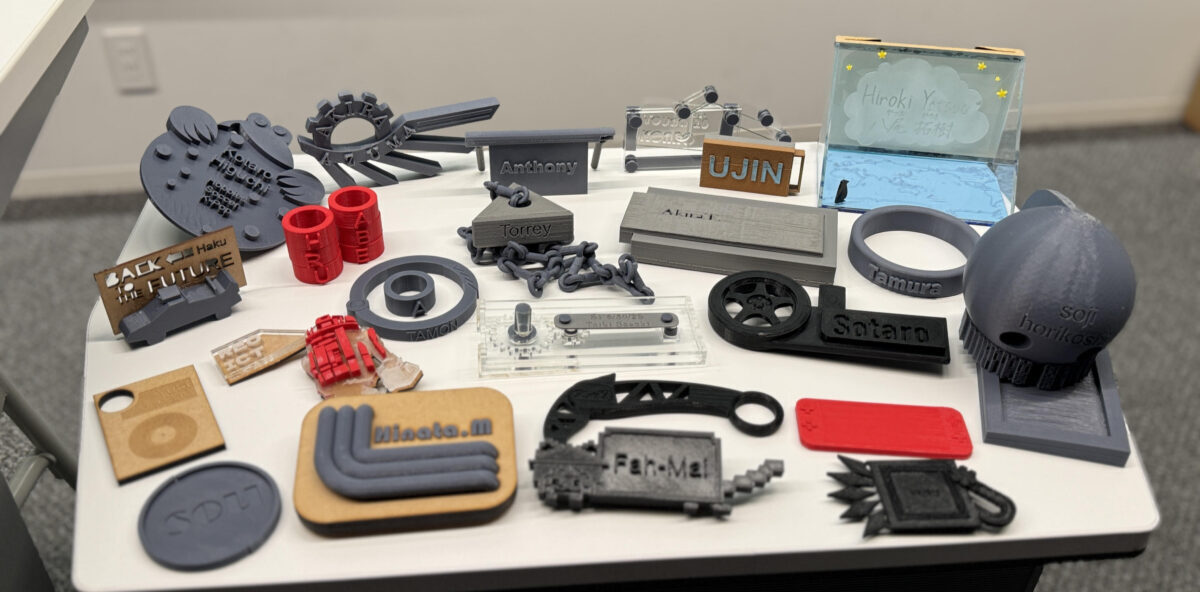 During this project students walked through how to come up with ideas, practiced prototyping, and learned about the connections between features and functions. This project culminated in a presentation where the students were able to “introduce” their nametags to their classmates, and practice their English-speaking skills.
During this project students walked through how to come up with ideas, practiced prototyping, and learned about the connections between features and functions. This project culminated in a presentation where the students were able to “introduce” their nametags to their classmates, and practice their English-speaking skills.
What I enjoy the most about Engineering Design is that, unlike tests and quizzes, there isn’t just one right answer to how to solve the problem. It was very interesting to see how the students decided to approach the challenge ahead of them. Many students focused on creating something that helped introduce their hobbies, or maybe a certain source of media that they enjoyed, allowing them to add parts of their personality into their final creation. This is just the first design experience for the students, so I am looking forward to where they go from here.
Project 2:Solving Problems through Teamwork
Within the first semester the first-year students also worked on a team project in Engineering Design IA. The goal of this project is for students to observe the world around them and identify the “Worst thing that they use everyday” and try to find a solution their individual pain points regarding the topic selected. An aspect of this project that I enjoy seeing is how students perceive and approach different challenges or inconveniences that they experience in their daily life. Each group tackled a very different problem, but they still needed to understand how an object is used, what are important features needed to complete a desired function, and a little about how people are an important part in designing a new product. We always get some interesting projects when we do this activity, so I am excited to share them all with you.
1. Ukusta
This group decided to take on the challenge of designing a new stand for the ukuleles found in the Living Commons at the Hakusanroku Campus. They wanted to make something that would stabilize the instrument while also helping to improve the visual aesthetics of the space.
2. Nosepads
This group decided to devise an adjustable attachment that could fit with various glasses or sunglasses, in order to help match the shape and contour of different noses. Due to the size that this type of attachment would need to be, for demonstration purposes only, their prototype was an enlarged version of their design.
3. The Tangle Terminator
This group decided to envision a way to help organize their laptop charging cables to improve upon its ability to be stored inside of a backpack, as most students do. They found that inside of the backpack, the cables tended to become tangled easily, which lead them to address this issue within the scope of portability.
4. Magnamewash
This group wanted to find a way to help organize the use of the laundry facilities within the Hakusanroku Campus dormitories. They wanted to help solve the issues of not knowing who is using what machine in an easy to install, easy to use way that would transfer information quickly and clearly.
5. Sortaro
This group found that sorting trash can be a difficult and time-consuming activity, and as someone who even after years of living in Japan still has challenges understanding this system I can relate. They wanted to make something that would still properly sort various types of garbage, but be in one easy to use location.
6. Shampoo Guardian Project
This group wanted to address the lack of shelving space within the showers at the Hakusanroku Campus dormitory. They wanted something that could be used within the shower stalls on campus, that was easy to carry and to access the various bottles that they wanted to use while showering.
I am looking forward to what they do in the second semester!
Brandon Wohlfarth










